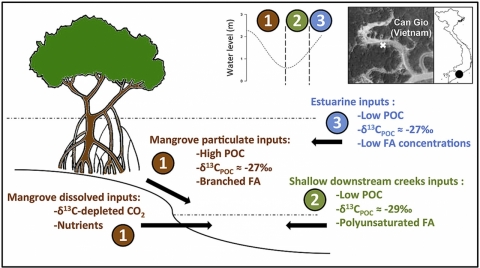
Nutritional composition of suspended particulate matter in a tropical mangrove creek during a tidal cycle (Can Gio, Vietnam). Frank David, Cyril Marchand, Pierre Taillardat, Nguyễn Thành-Nho, Tarik Meziane (2018) , Estuarine, Coastal and Shelf Science, Volume 200, Pages 126-130, ISSN 0272-7714.
Mangrove forests are highly productive ecosystems and mangrove-derived organic matter has generally been assumed to play a basal role in sustaining coastal food webs. However, the mechanisms of mangrove-derived organic matter utilisation by consumers are not fully understood. In this study, we were interested in hourly changes in the nutritional quality of suspended particulate matter (SPM) entering and departing a mangrove creek during a tidal cycle. We determined the fatty acid composition and δ13C stable isotope signature of SPM during a 26 h tidal cycle in a creek of the Can Gio Mangrove Biosphere Reserve (Southern Vietnam). Regarding fatty acids, the nutritional quality of SPM was low during most of the tidal cycle. However, it greatly increased during the first part of the strongest flood tide, occurring during daytime. The pulse of highly nutritive organic matter brought to the ecosystem was mostly composed of algal cells growing in specific shallow zones of the mangrove, that use nutrients and CO2 exported during the preceding ebb tide and originating from the mineralisation of mangrove-derived organic matter, as evidenced by their δ13C signatures. This study confirms that mangrove-derived carbon plays a basal role in sustaining trophic webs of mangrove tidal creeks, but that its nutritive value is greatly enhanced when a first step of mineralisation is achieved and CO2 is photosynthesised by algal cells.
BOREA Contact: Pr Tarik Meziane : meziane@mnhn.fr




